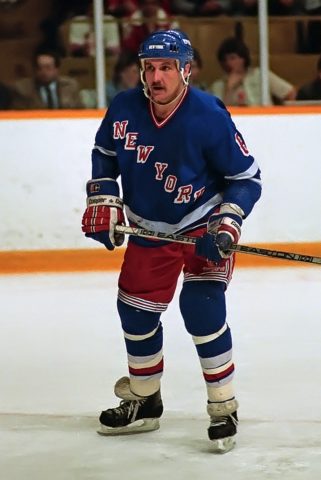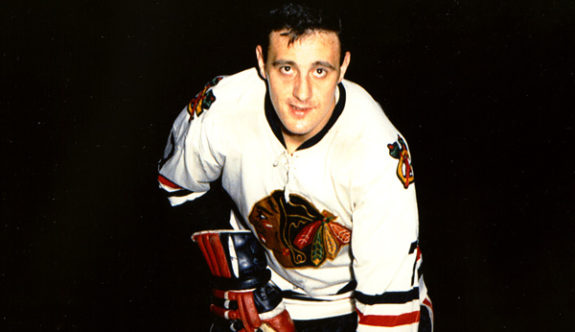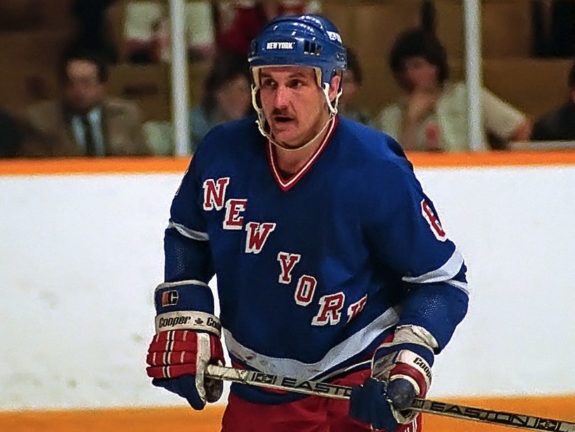
 Tom Castro
The Hockey Writers
Tom Castro
The Hockey Writers
59
Reads
0
Comments
Walt Poddubny: Rangers’ Brief and Tragic Star
For established world-class athletes, joining a team in New York City from elsewhere always has been, and always will be, a different animal.
A select group of imported players thrives under the white-hot spotlight, while many more wilt under the pressure of rabid fanbases and the unrelenting coverage of the Big Apple’s media horde, an often-shocking entity for those unfamiliar with its ways. Occasionally, a star player can find a comfortable under-the-radar niche that allows him to perform in what amounts to a supporting role – though that occurrence is about as rare as finding a cab on Fifth Avenue at 5 p.m. during the week.
For every Paul O’Neill, there are many more Randy Johnsons. For every Mark Messier and Reggie Jackson, there are numerous Wade Reddens and Kenny Rogers.
The common thread of such comparisons, however, is that toast of the big town or utter failure, those players came to New York as already established stars or near-stars, looking to chase glory on sports’ biggest stage for their next chapter. The latest is the New York Rangers’ Artemi Panarin, the dynamic forward formerly of the Chicago Blackhawks and Columbus Blue Jackets whose desire to play in the spotlight led him to turn down bigger contract offers from the Jackets and New York Islanders, instead inking a seven-year, $81.5-million free agent deal July 1 to star on Broadway.

But what about the athlete who needs Gotham to become a star?
The list of players who fashioned unspectacular careers before hitting it big in the Big Apple isn’t nearly as long. Thirty-three years ago, the New York Rangers added one to those ranks – and though it proved to be a brief moment, it certainly was electric while it lasted.
Poddubny Went from Unknown to MSG Favorite
On Aug. 18, 1986, Walter Michael Poddubny arrived in New York, acquired by general manager Phil Esposito for fading veteran Mike Allison from the Toronto Maple Leafs.

Standing a stout 6-foot-1 and 210 pounds, Poddubny had shown flashes of offensive ability through five NHL seasons. There was a 28-goal effort in his first full season of 1982-83, perhaps hinting at something special, but he was only able to match that total in 103 games over the next three seasons.
The kid from Thunder Bay, Ontario hadn’t done nearly enough to indicate that a truly elite offensive force was about to emerge in 1986-87. That, however, is precisely what would transpire over that season and the next.
A little-known player when his first season in a Blueshirt started, Poddubny surged into the NHL spotlight, scoring 40 goals and adding 47 assists in a career-high 75 games. Proving it was no fluke, he followed it up with a 38-goal, 50-assist effort in 1987-88, easily leading a pair of mostly middling teams in scoring both seasons.
The performance was stunning. Esposito had unearthed a natural goal scorer, seemingly always in the right place at the right time. Never the fastest or strongest player, Poddubny simply scored and scored over two amazing seasons in front of the Madison Square Garden faithful, earning the roars of New York City sports fans that so many athletes seek, only to fall short because of all that comes with such a quest.
Maybe Poddubny was on the verge of a breakout by ’86-’87, likely to produce at a high level regardless of who he played for. While that’s possible, the subsequent events of 1988-89 might provide more than a hint that location indeed played a role.
Ill-Fated Trade to Nordiques Started Poddubny’s Downward Spiral

The Rangers’ daring – many would call it scattershot and random – approach to personnel in Esposito’s three years as GM delivered an unknown commodity to New York in Poddubny. That philosophy is also what led to his ill-advised departure. Few longtime Blueshirts fans can forget the “Trader Phil” days at MSG, as Esposito haphazardly shipped players in and out of town, searching for … something.
Guy LaFleur was signed out of retirement for the ’88-’89 season, while Esposito acquired Marcel Dionne for his final three NHL seasons (though in fairness, both future Hall of Famers played fairly well during their time in New York, whether those moves began as publicity stunts or not).
Ultimately, Esposito’s impetuous ways at the personnel controls yielded too many mistakes and not nearly enough cohesion. The acquisition of Poddubny, his finest trade with the Rangers, ended up being the centerpiece of perhaps his worst.
On Aug. 1, 1988, for no apparent reason, Esposito shipped a player who had recorded 175 points in 152 games for his team to the Quebec Nordiques as part of a trade for eight-year veteran Normand Rochefort, a hard-nosed defenseman who was the 24th pick in the 1980 draft but nonetheless didn’t come close to matching Poddubny’s value.

Rochefort played four injury-plagued seasons with the Rangers, averaging only 28 games per. Center Jason Lafreniere, the other key pickup in the deal for the Blueshirts, also had little impact.
The deal was a bad one for the Rangers. It took less than three months for Poddubny’s former fanbase to realize just how bad it had also been for him.
Return to MSG Revealed Poddubny’s Pain
A return to the arena where he had authored two seasons of magic came quickly for Poddubny, the Nordiques making their only visit of the season to MSG on Oct. 23, 1988. The Rangers pounded Quebec 8-2, and Poddubny conducted a between-periods interview with Bruce Beck, a staple of Rangers’ broadcasts on MSG Network at the time.
Beck, aware that Poddubny had not been happy about leaving New York, centered the brief one-on-one on that subject. The responses from Poddubny to Beck’s questions might come across today as shocking, given the carefully practiced approach of delivering vanilla, unrevealing statements to the media by teams and athletes in the current sports landscape.
Asked if he had not been interested in leaving, a visibly crestfallen Poddubny frankly confirmed that he hadn’t wanted to go to the Nordiques, qualifying it somewhat by calling Quebec a “beautiful city,” but also expressing how happy he had been in the Big Apple.
The return to MSG so soon after the late-offseason trade was made worse by the game’s result, which seemingly led to another expression of Poddubny’s frustration. With his team getting blown out after a four-goal Rangers first period, Poddubny led a Nordiques rush later in the game, only to have the play whistled offsides. The left-handed shot, who didn’t record a point in the game, fired the puck angrily against the right boards, his feelings boiling over in another open display of emotion so rarely seen in professional athletes today.

Poddubny’s sadness over leaving the city where he became an unexpected and beloved star didn’t affect his production in ’88-’89, as he posted 38 goals – giving him 116 over three seasons – to go with 37 assists. That season, though, marked the beginning of ends for the two key principles in the fateful trade of Aug. 1986.
Esposito was dismissed following that campaign, the Rangers having failed to make it past the first round of the playoffs in the GM’s three seasons amidst the constant roster upheaval. While Esposito would bounce back, Poddubny’s prospects only trended downward from then on.
Poddubny’s Post-NHL Problems Ended in Early Death
Traded to the New Jersey Devils that offseason, Poddubny would score only nine goals over his final three seasons, his career derailed by knee problems that limited him to 54 more games after his one season in Quebec. He retired at age 35.
And so began Poddubny’s struggles with post-NHL life. He tried coaching, to so-so results. He got divorced, struggled to hold a job and had problems with alcohol. Poddubny’s stellar three seasons between the Rangers and Nordiques would have earned him tens of millions in today’s NHL; that wasn’t the case back then. He claimed the most he ever made was $350,000.
“People think if you played in the NHL, you’re set for life,” he said. “It’s not like that for everyone.”
When Poddubny died in 2009 at age 49 of a heart attack, he was living in the basement of his sister Irene’s home. The outpouring of sympathy that followed showed that Poddubny had made quite an impression in his limited time as a top NHL goal scorer.
“It’s unbelievable,” Irene said shortly after his death. “The calls have come from across the country. He was well-loved. He had a great public persona.”
Poddubny’s tragic story can hardly be classified as a cautionary tale. Rather, he was a victim of circumstance and the astronomical odds against becoming a famous and wildly rich athlete – even one with elite ability – who sails into retirement at a relatively young age, financially secure.
Rangers fans who are old enough to remember those two seasons at Madison Square Garden, though, will always have a fondness for the stocky winger who seemingly emerged from nowhere to deliver plenty of thrilling moments. Not a whirlwind offensive force in the mold of Panarin, he was nonetheless a star who gave the faithful something to cheer about in those mostly mediocre years, albeit briefly. Poddubny and Tomas Sandstrom each delivered 40 goals in 1986-87, a feat accomplished by Rangers teammates in the same season only once since.
Poddubny’s finest years, in fact, might well have been his two in the New York spotlight – high points of a life sadly cut way too short and a career that serves now as a study in what might have been.
The post Walt Poddubny: Rangers’ Brief and Tragic Star appeared first on The Hockey Writers.
Popular Articles

















































 Blackhawks Chicago
Blackhawks Chicago Panthers Florida
Panthers Florida Penguins Pittsburgh
Penguins Pittsburgh Rangers New York
Rangers New York Avalanche Colorado
Avalanche Colorado Kings Los Angeles
Kings Los Angeles Maple Leafs Toronto
Maple Leafs Toronto Bruins Boston
Bruins Boston Capitals Washington
Capitals Washington Flames Calgary
Flames Calgary Oilers Edmonton
Oilers Edmonton Golden Knights Vegas
Golden Knights Vegas Senators Ottawa
Senators Ottawa Lightning Tampa Bay
Lightning Tampa Bay Flyers Philadelphia
Flyers Philadelphia Red Wings Detroit
Red Wings Detroit Islanders New York
Islanders New York Sabres Buffalo
Sabres Buffalo Devils New Jersey
Devils New Jersey Hurricanes Carolina
Hurricanes Carolina Stars Dallas
Stars Dallas Jets Winnipeg
Jets Winnipeg Blue Jackets Columbus
Blue Jackets Columbus Predators Nashville
Predators Nashville Wild Minnesota
Wild Minnesota Blues St. Louis
Blues St. Louis Mammoth Utah
Mammoth Utah Ducks Anaheim
Ducks Anaheim Canucks Vancouver
Canucks Vancouver Sharks San Jose
Sharks San Jose






